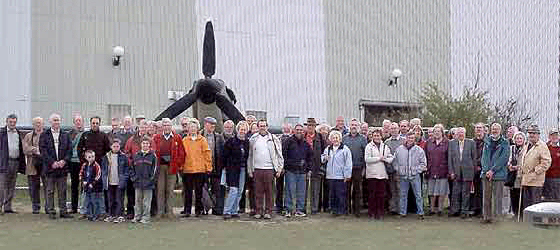|
::
[ SVVS Visit to The imperial War Museum, Duxford - April, 2003 ] ::
The following text is based on the SVVS Magazine
report by Chris Cuss and the photos are by Tony Oakes and Bozi Mohacek.
Please click on any thumbnail picture below to see the full size
picture. To return to the thumbnails please click the Explorer
"Back" arrow (top left of screen). Pictures have been prepared
for speed of loading, and the page has been sized to be viewed at
800 x 600.

Following a successful coach trip to visit the Enigma museum at
Bletchley Park, this year's journey took us to the Imperial War Museum's
aviation collection at Duxford, a former World War II fighter station,
near Cambridge. The coach journey was confortable and I must make
comment of the inflight drinks service provided and
hope that next year we will be served peanuts in un-tearable bags to
complete the airline experience.

Being sited on an airfield the museum covers a large area. The aircraft
collection is housed in five hangers in addition to which separate
buildings house the American Air Museum and the Military Vehicle
collection. Thankfully there was a shuttle vehicle linking all the
exhibit areas.




The first hanger contained some of the collection's
larger aircraft including a Lancaster bomber and a Sunderland flying
boat. Pride of place went to the pre-production Concorde. This plane had
never been in airline service but was used for flight
trials and had flown higher and faster than any of its siblings. Sadly the
demise of the Concorde fleet had been announced only days before our
visit.








Hanger Two contained a collection of World War II fighters many of which
were airworthy and put in appearances at air shows across the country.
Hanger Three was a more eclectic mix with a miniature submarine and a
lifeboat mingled amongst the aircraft. The fourth hanger was dedicated
to the Battle of Britain and Duxford's wartime role was the subject of a
short video film. As some of us will know, it was home to Douglas
Bader's controversial `Big Wing'. When America joined the war Duxford
became home to Thunderbolts of the 7th Air Force. The final hanger was
the restoration workshop where heroic renovation work was being carried
out by a team of volunteers.








Sadly not all of Duxford's aircraft are able to be stored under cover.
There were a number of post-war airliners on the hard standing including
the oldest surviving Viscount, a VC 10 and a very sad looking Victor
bomber. Set aside from this group was a Hastings transport aircraft that
had once been flown by our member Robin Vince. Another former pilot is
your worthy editor who was re-united with the Vickers Varsity in which
he had more than a few hairy moments whilst flying trainee
navigators around the country. Sadly he was unable to gain access to the
cockpit. However Julian was able to take to the air in the Dragon Rapide
biplane that was giving joyrides over the airfield during the day. Other
intrepid passengers included David Smart, Nigel Walder, Julian's better
half Thelma and Frank Clemmy and his son. My spies tell me that the
latter pair were `bounced' off their booked flight as they upset the
aircraft's trim. Happily they were put on a later flight.




The most impressive building on the airfield has to be the award winning
American museum that was opened in 1998 as a memorial to all those
airmen from the U.S. who lost their lives during the last war. Outside
glass panels were etched with the silhouettes of every aircraft that
failed to return commemorate their sacrifice. Inside the domed building,
so much better than Greenwich, centre stage is taken by a B52. Once
again this giant bomber has been much in the news recently during the
bombing of Baghdad. Around the B52 were not only all the major aircraft
flown by the Army Air Corps but also those from more recent years
including the amazing 5R71 Blackbird reconnaissance plane. Thishas flown faster and higher than anything other than a spacecraft. At
the other extreme those of us who enjoyed our wing walking after dinner
speaker last February were pleased to see a tiny Stearman biplane
suspended from the roof and easily viewed from the elevated walkway.









The final building housed the museum's collection of fighting vehicles.
Included were armoured fighting vehicles from all sides in World War II
as well as more modern types. All were displayed in as realistic
settings as possible. Tanks hid behind broken buildings, jeeps were
displayed in recreated battle ield scenes and everything was covered
with a most realistic covering of mud. Not a shiny sterile exhibit to be
seen so some of our Riley owning members felt quite at home. The far end
of the hall contained the Normandy Experience, a recreation of the
invasion, which we entered by walking through a landing craft and onto
the beach. A German sniper positioned on an adjacent house was quickly
spotted by Derek Wright who nonetheless refused to crawl on his stomach
around the exhibits. Also in this section was the group of vehicles used
by Montgomery as his mobile headquarters including one captured from the
Germans at Alamein.












By four o'clock all our now footsore but happy members were back on the
coach save one for whom the attraction of the shop proved too much.
Thankfully he was retrieved by `her indoors' and so a full coach
returned to Merstham. As ever our thanks go to the indefatigable Derek
and Jacqui for all their hard work in making the day a success.
















Return to Recent Venues Page
|